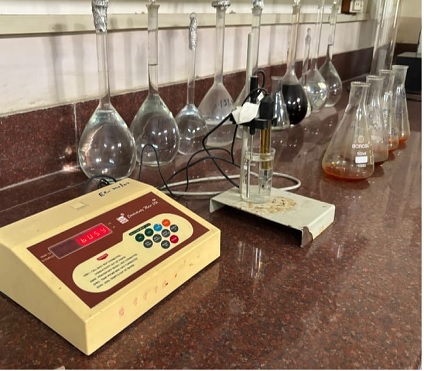Soil Testing
Soil Testing
Soil testing is a process that analyzes the chemical, physical, and biological properties of soil. It can be used for agriculture, construction, and environmental assessment. Soil testing is an essential component of soil resource management. Each sample collected must be a true representative of the area being sampled. Utility of the results obtained from the laboratory analysis depends on the sampling precision. Hence, collection of large number of samples is advisable so that sample of desired size can be obtained by sub-sampling.In general, sampling is done at the rate of one sample for every two-hectare area.
Objectives of soil testing
• Accurate information about the nutrients present in the soil.• Determining the correct amount of fertilizers for the targeted crop yield based on the test.
• Determining the correct amount of appropriate soil improvers by testing acidic and alkaline soil.
• Preparing soil fertility maps on the scale of specific areas such as village, block and district on
the basis of soil testing, so that general recommendations can be made for farmers or
it can prove helpful for policy makers.
Materials required
• Spade or auger (screw or tube or post hole type)• Khurpi
• Core sampler
• Sampling bags
• Plastic tray or bucket
Points to be considered
• Collect the soil sample during fallow period.• In the standing crop, collect samples between rows.
• Sampling at several locations in a zig-zag pattern ensures homogeneity.
• Fields, which are similar in appearance, production and past-management practices, can be grouped into a single sampling unit.
• Collect separate samples from fields that differ in colour, slope, drainage, past management practices like liming, gypsum application, fertilization, cropping system etc.
• Avoid sampling in dead furrows, wet spots, areas near main bund, trees, manure heaps and irrigation channels.
• For shallow rooted crops, collect samples up to 15 cm depth. For deep rooted crops, collect samples up to 30 cm depth.
Procedure
• Divide the field into different homogenous units based on the visual observation and farmer’s experience.
• Remove the surface litter at the sampling spot.
• Drive the auger to a plough depth of 30 cm and draw the soil sample.
• Collect at least 10 to 15 samples from each sampling unit and place in a bucket or tray.
• If auger is not available, make a ‘V’ shaped cut to a depth of 30 cm in the sampling spot using spade.
• Remove thick slices of soil from top to bottom of exposed face of the ‘V’ shaped cut and place in a clean container.
Figure 1 Soil depth for sampling
Quarter method for representative soil sample• Mix the samples thoroughly and remove foreign materials like roots, stones, pebbles and gravels.
• Reduce the bulk to about half to one kilogram by quartering or compartmentalization.
• Quartering is done by dividing the thoroughly mixed sample into four equal parts. The two opposite quarters are discarded and the remaining two quarters are remixed and the process repeated until the desired sample size is obtained.
• Compartmentalization is done by uniformly spreading the soil over a clean hard surface and dividing into smaller compartments by drawing lines along and across the length and breadth. From each compartment a pinch of soil is collected. This process is repeated till the desired quantity of sample is obtained.
• Collect the sample in a clean cloth or polythene bag.
• Label the bag with information like name of the farmer, location of the farm, survey number, previous crop grown, present crop, crop to be grown in the next season, date of collection etc.
Figure 2 Method for representative soil samples
Sampling time
• Before planting the autumn sugarcane crop, soil samples must be taken in the month of May-June i.e. before the rains.• If the plot is smaller than one acre, then it would be appropriate to take primary samples from 6-7 places and if it is larger than one acre, then it would be appropriate to take primary samples from about 12-13 places.
• If sugarcane crop is planted in the field and it is necessary to take soil samples, then the sample should be collected from between the rows.



